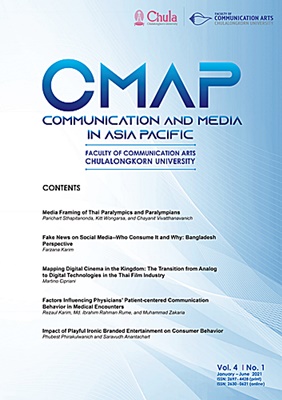Media Framing of Thai Paralympics and Paralympians
Main Article Content
Abstract
The objective of this study is to find out how local newspapers in Thailand reported the Paralympic Games and the Thai Paralympians during the period of 2012 London Paralympics. As an empirical study, we applied the framing methodology to analyze the 2012 London Paralympics news of the top three newspapers in Thailand: Bangkok Post (the leading English newspaper), Thai Rath (the most popular Thai newspaper), and Siam Sport News (the biggest sport newspaper). The quantitative results showed that Thai newspapers paid most attention in reporting news of Paralympics after the games were over. The most popular frame was about rewards given to the Paralympic winners. By applying Thai dramatic frames to analyze the stories of Thai Paralympians, orphan characteristic was most framed as an image of Thai Paralympians.
Article Details
References
Akraudom, A. (2009). Development of brand archetype concept and its measurement for marketing communication applications. Doctoral dissertation, Faculty of Communication Arts, Chulalongkorn University, Bangkok, Thailand.
Bernard, S., Butler, K., Golding, P., & Maguire, J. (2004). ‘Making the News’: The 2004 Athens Olympics and competing ideologies 2006. Olympika, XV, 35-56.
Billings, A. C., Angelini, J. R., & Duke, A. H. (2010). Gendered profiles of Olympic history: Sportscaster dialogue in the 2008 Beijing Olympics. Journal of Broadcasting & Electronic Media, 54(1), 9-23.
Cohen, B. C. (1963). The press and the foreign policy. Princeton, NJ: Princeton University Press.
DePauw, K., & Gavron, S. (1995). Disability and sport. Champaign, IL: Human Kinetics.
Entman, R. M. (1993). Framing: Toward clarification of a fractured paradigm. Journal of Communication, 43(5), 51-58.
Entman, R. M. (2004). Projections of power: Framing news, public opinion, and U.S. foreign policy. Chicago: University of Chicago Press.
Gamson, W. A. (1989). News as framing. American Behavioral Scientists, 33, 157-161.
Gamson, W. A., & Modigliani, A. (1989). Media discourse and public opinion on nuclear power: A constructionist approach. American Journal of Sociology, 95, -37.
Gitlin, T. (1980). The whole world is watching: Mass media in the making and unmaking of the new left. Berkeley, CA: University of California Press.
Gross, K., & D’Ambrosio, L. (2004). Framing emotional response. Political Psychology, 25(1), 1–29.
Goffman, E. (1974). Frame analysis: An essay on the organization of experience. New York: Harper & Row.
Griffin, E. (2012). A first look at communication theory. Singapore: McGraw- Hill.
International Paralympic Committee (2008). Paralympic Games. Retrieved January 21, 2020, from http://www.paralympic.org/ ParalympicGames
International Paralympic Committee (2012). Paralympic Games. Retrieved January 21, 2020, from http://www.paralympic.org/ ParalympicGames
Iyengar, S., & Simon, A. (1993). News coverage of the Gulf Crisis and public opinion--A study of agenda-setting, priming, and framing. Communication Research, 20, 365–383.
Kim, S. H., Scheufele, D. A., & Shanahan, J. (2002). Think about it this way: Attribute agenda-setting function of the press and the public’s evaluation of a local issue. Journalism & Mass Communication Quarterly, 79(1), 7–25.
National Office for Empowerment of Persons with Disabilities. (2014). Ministry of Social Development and Human Security, Thailand. Retrieved January 20, 2020, from http://www.m-society.go.th/
Lippmann, W. (1922). Public opinion. New York, NY: Macmillan.
McCombs, M. (1994). News influence on our pictures of the world. In J. Bryant & D. Zillmann (Eds), Media effects: Advances in theory and research. Mahwah, NJ: Lawrence Erlbaum Associates.
McCombs, M. (1997). New frontiers in agenda setting: Agendas of attributes and frames. Mass Comm Review, 24, 4-24.
McCombs, M., & Shaw, D. (1972). The agenda-setting function of the mass media. Public Opinion Quarterly, 36, 176-187.
Price, V., Tewksbury, D., & Powers, E. (1997). Switching trains of thought: The impact of news frames on readers’ cognitive responses. Communication Research, 24, 481–506.
Rivenburgh, N. K. (2004). Sport, Media, and Peace. Apunts, 78, 4.
Schantz, O. J., & Gilbert, K. (2001). An ideal misconstrued: Newspaper coverage of the Atlanta Paralympic Games in France and Germany. Sociology of Sport Journal, 18(1), 69– 94.
Scheufele, D. A. (1999). Framing as a theory of media effects. Journal of Communication, 49(1), 103-120.
Scheufele, D. A. (2000). Agenda-setting, priming, and framing revisited: Another look at cognitive effects of political communications. Mass Communication and Society, 3(2-3), 297-316.
Sikorski, C., & Schierl, T. (2011). Sports communication & disability: Media framing and effects on recipients’ perception and evaluation of persons with disability. Paper presented at the International Association for Media and Communication Research Conference, Istanbul, Turkey.
Sikorski, C., & Schierl, T. (2012). Effects of news frames on recipients’ information processing in disability sports communications. Journal of Media Psychology, 24(3),113-123.
Tuchman, G. (1978). Making news: A study in the construction of reality. New York, NY: Free Press.
Van Gorp, B., Vettehen, P. H., & Beentjes, J. W. J. (2009). Challenging the frame in the news: The role of issue involvement, attitude, ad competing frames. Journal of Media Psychology, 21(4), 161-170.
Wicks, R. H. (2005). Thoughts on agenda setting, framing, and priming. Journal of Communication, 57(1), 142-147.
Walters, C., & Merphy, S. (2008). Framing the Olympic Games: Impact of American television coverage on attitudes toward international cooperation and foreign policy in the United States. American Journal of Media Psychology, 1(1-2), 76-102.


